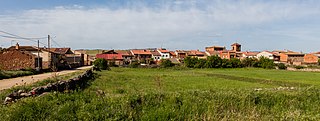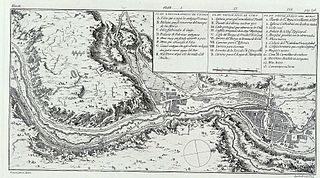
Club Deportivo Numancia de Soria, S.A.D. is a Spanish football club in Soria, in the autonomous community of Castile and León. Founded on 9 April 1945, it plays in Segunda Federación – Group 5, holding home games at Nuevo Estadio Los Pajaritos.

The Province of Burgos is a province of northern Spain, in the northeastern part of the autonomous community of Castile and León. It is bordered by the provinces of Palencia, Cantabria, Vizcaya, Álava, La Rioja, Soria, Segovia, and Valladolid. Burgos is the province of Spain that has borders with most provinces. Its capital is the city of Burgos.

The Celtiberians were a group of Celts and Celticized peoples inhabiting an area in the central-northeastern Iberian Peninsula during the final centuries BC. They were explicitly mentioned as being Celts by several classic authors. These tribes spoke the Celtiberian language and wrote it by adapting the Iberian alphabet, in the form of the Celtiberian script. The numerous inscriptions that have been discovered, some of them extensive, have allowed scholars to classify the Celtiberian language as a Celtic language, one of the Hispano-Celtic languages that were spoken in pre-Roman and early Roman Iberia. Archaeologically, many elements link Celtiberians with Celts in Central Europe, but also show large differences with both the Hallstatt culture and La Tène culture.

Soria is a municipality and a Spanish city, located on the Douro river in the east of the autonomous community of Castile and León and capital of the province of Soria. Its population is 38,881, 43.7% of the provincial population. The municipality has a surface area of 271,77 km2, with a density of 144.97 inhabitants/km2. Situated at about 1065 metres above sea level, Soria is the second highest provincial capital in Spain.

Numantia is an ancient Celtiberian settlement, whose remains are located on a hill known as Cerro de la Muela in the current municipality of Garray (Soria), Spain.

The Museum of Gold is an archaeology museum located in Bogotá, Colombia. It is one of the most visited touristic highlights in the country. The museum receives around 500,000 tourists per year.

Torralba and Ambrona are two paleontological and archaeological sites that correspond to various fossiliferous levels with Acheulean lithic industry associated, at least about 350,000 years old. The sites, traditionally studied together, are about 3 km distant, and belong to the settlements of Ambrona and Torralba del Moral.

The Celtiberian oppidum of Numantia was attacked more than once by Roman forces, but the siege of Numantia refers to the culminating and pacifying action of the long-running Numantine War between the forces of the Roman Republic and those of the native population of Hispania Citerior. The Numantine War was the third of the Celtiberian Wars and it broke out in 143 BC. A decade later, in 133 BC, the Roman general and hero of the Third Punic War, Scipio Aemilianus Africanus, subjugated Numantia, the chief Celtiberian city.

The Arevaci or Aravaci, were a Celtic people who settled in the central Meseta of northern Hispania and dominated most of Celtiberia from the 4th to late 2nd centuries BC. The Vaccaei were their allies.

Montejo de Tiermes is a municipality located in the province of Soria, Castile and León, Spain. In 2010 the population of Montejo de Tiermes (municipality) was 198 inhabitants, 126 men and 72 women. Montejo de Tiermes (locality) had a population of 58 inhabitants on 1 January 2010, 41 men and 17 women.
Txomin Nagore Arbizu is a Spanish former professional footballer who played as a defensive midfielder.

Club Deportivo Numancia de Soria "B" is the reserve team of CD Numancia, sports club from Soria. The club is named after the ancient Celtiberian town of Numantia, near present-day Soria. Founded in 1979, currently plays in Tercera División – Group 8, holding home games at Ciudad del Fútbol Francisco Rubio Garcés, with a 1,000-seat capacity.

The Pellendones were an ancient pre-Roman Celtic people living on the Iberian Peninsula. From the early 4th century BC they inhabited the region near the source of the river Duero in what today is north-central Spain. The area comprises the north of Soria, the southeast of Burgos and the southwest of La Rioja provinces.

Garray is a municipality located in the province of Soria, Castile and León, Spain.

Soria is a city located in modern-day north-central Spain. As of 2010, the municipality has a population of approximately 39,500 inhabitants, nearly 40% of the population of the province.

Uxama Argaela was a Celtiberian, and subsequently Roman, city located on El Castro hill, overlooking the present town of El Burgo de Osma in Soria, Spain.

Termantia, the present-day locality of Tiermes, is an archaeological site on the edge of the Duero valley in Spain. It is located in the sparsely populated municipio of Montejo de Tiermes.

The National Museum of Peru is a national museum in Lurín District, Lima, Peru, located within the archaeological zone of Pachacamac. The museum will hold over a half million artifacts of the Pre-Columbian era and Inca Empire, ranging back to 5,000 BCE. It opened in July 2021 as part of Peru's bicentennial celebrations and is capable of accepting 15,000 guests per day.

The Pontevedra Museum is a museum in the Galician city of Pontevedra in Spain. It was founded by the Provincial Deputation of Pontevedra on 30 December 1927 and has six buildings for its exhibitions. It has permanent and temporary exhibition rooms. The museum's collections are multidisciplinary, classified into rooms for painting, sculpture, archaeology, decorative arts, engraving and ethnography.


















